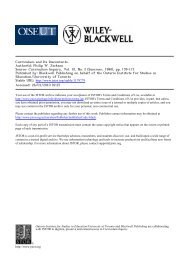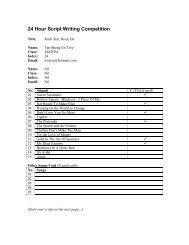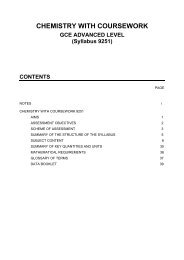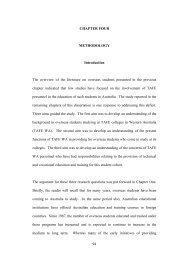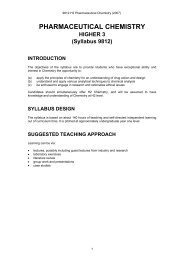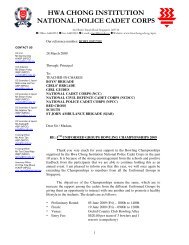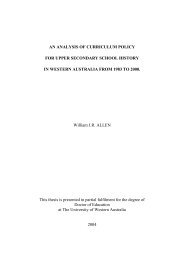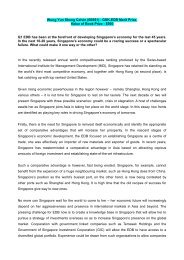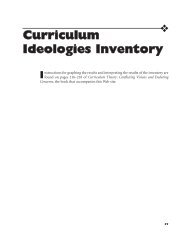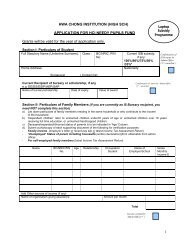9812 H3 Chemistry
9812 H3 Chemistry
9812 H3 Chemistry
Create successful ePaper yourself
Turn your PDF publications into a flip-book with our unique Google optimized e-Paper software.
PHARMACEUTICAL CHEMISTRY<br />
HIGHER 3<br />
(Syllabus <strong>9812</strong>)<br />
CONTENTS<br />
Page<br />
INTRODUCTION 1<br />
SYLLABUS DESIGN 1<br />
SUGGESTED TEACHING APPROACH 1<br />
ASSESSMENT OBJECTIVES 2<br />
SCHEME OF ASSESSMENT 3<br />
WEIGHTING OF ASSESSMENT OBJECTIVES 3<br />
ADDITIONAL INFORMATION 3<br />
SUBJECT CONTENT 4<br />
MATHEMATICAL REQUIREMENTS 17<br />
GLOSSARY OF TERMS 18<br />
DATA BOOKLET 20
<strong>9812</strong> <strong>H3</strong> PHARMACEUTICAL CHEMISTRY (2009)<br />
INTRODUCTION<br />
The objectives of the syllabus are to provide students who have exceptional ability and<br />
interest in <strong>Chemistry</strong> the opportunity to:<br />
(a)<br />
(b)<br />
(c)<br />
apply the principles of chemistry for an understanding of drug action and design<br />
understand and apply various analytical techniques to chemical analysis<br />
be enthused to engage in research and rationalise ethical issues<br />
Candidates should simultaneously offer H2 <strong>Chemistry</strong>, and will be assumed to have<br />
knowledge and understanding of <strong>Chemistry</strong> at H2 level.<br />
SYLLABUS DESIGN<br />
The syllabus is based on about 140 hours of teaching and self-directed independent learning<br />
out of curriculum time. It is pitched at approximately undergraduate year one level.<br />
SUGGESTED TEACHING APPROACH<br />
Learning can be via:<br />
• lectures, possibly including guest lectures from industry and research<br />
• laboratory exercises<br />
• literature review<br />
• group work and presentations<br />
• case studies<br />
1
<strong>9812</strong> <strong>H3</strong> PHARMACEUTICAL CHEMISTRY (2009)<br />
ASSESSMENT OBJECTIVES<br />
A<br />
Knowledge with understanding<br />
Students should be able to demonstrate knowledge with understanding in relation to:<br />
1. scientific phenomena, facts, laws, definitions, concepts, theories;<br />
2. scientific vocabulary, terminology, conventions (including symbols, quantities<br />
and units);<br />
3. scientific instruments and apparatus, including techniques of operation and<br />
aspects of safety;<br />
4. scientific quantities and their determination;<br />
5. scientific and technological applications with their social, economic and<br />
environmental implications;<br />
The Syllabus Content defines the factual knowledge that candidates may be required<br />
to recall and explain. Questions testing these objectives will often begin with one of the<br />
following words: define, state, describe, explain or outline. (See the Glossary of Terms.)<br />
B<br />
Handling, applying and evaluating information<br />
Students should be able in words or by using symbolic, graphical and numerical forms<br />
of presentation to:<br />
1. locate, select, organise and present information from a variety of sources;<br />
2. handle information, distinguishing the relevant from the extraneous;<br />
3. manipulate numerical and other data and translate information from one form to<br />
another;<br />
4. analyse and evaluate information so as to identify patterns, report trends and<br />
conclusions, and draw inferences;<br />
5. present reasoned explanations for phenomena, patterns and relationships;<br />
6. construct arguments to support hypotheses or to justify a course of action;<br />
7. apply knowledge, including principles, to novel situations;<br />
8. evaluate information and hypotheses;<br />
9. demonstrate an awareness of the limitations of chemistry theories and models;<br />
10. bring together knowledge, principles and concepts from different areas of<br />
chemistry, and apply them in a particular context;<br />
11. use chemical skills in contexts which bring together different areas of the subject.<br />
2
<strong>9812</strong> <strong>H3</strong> PHARMACEUTICAL CHEMISTRY (2009)<br />
These assessment objectives cannot be precisely specified in the Syllabus Content because<br />
questions testing such skills may be based on information which is unfamiliar to the<br />
candidate. In answering such questions, candidates are required to use principles and<br />
concepts that are within the syllabus and apply them in a logical, reasoned or deductive<br />
manner to a novel situation. Questions testing these objectives will often begin with one of<br />
the following words: predict, suggest, construct, calculate or determine. (See the Glossary of<br />
Terms.)<br />
SCHEME OF ASSESSMENT<br />
Candidates will take a 2 h 30 min paper (100 marks total). Candidates choose five out of six<br />
free-response questions. Each question carries 20 marks, and requires integration of<br />
knowledge from the different sections in the syllabus.<br />
WEIGHTING OF ASSESSMENT OBJECTIVES<br />
A<br />
B<br />
Assessment Objectives<br />
Knowledge with<br />
understanding<br />
Handling, applying and<br />
evaluating information<br />
Weighting<br />
30%<br />
70%<br />
ADDITIONAL INFORMATION<br />
Data Booklet<br />
A Data Booklet is available for use in the examination paper. The booklet is reprinted at the<br />
end of this syllabus document.<br />
Nomenclature<br />
Students will be expected to be familiar with the nomenclature used in the syllabus.<br />
The proposals in "Signs, Symbols and Systematics" (The Association for Science Education<br />
Companion to 16-19 Science, 2000) will generally be adopted although the traditional names<br />
sulfate, sulfite, nitrate, nitrite, sulfurous and nitrous acids will be used in question papers.<br />
Sulfur (and all compounds of sulfur) will be spelt with f (not with ph) in question papers,<br />
however students can use either spelling in their answers.<br />
3
<strong>9812</strong> <strong>H3</strong> PHARMACEUTICAL CHEMISTRY (2009)<br />
SUBJECT CONTENT<br />
1. EFFECTS AND DEVELOPMENT OF DRUGS<br />
This section introduces the general properties and functions of drugs. It gives a<br />
general idea of how drugs are designed, developed, and tested, including the use of<br />
structural modification, asymmetric synthesis to get the desired optical isomer, and<br />
drug testing made before drugs are introduced to the public. Candidates should be<br />
aware of the contribution that science has made (and continues to make) towards<br />
maintaining the health and well-being of the world’s population.<br />
1.1 EFFECTS OF DRUGS<br />
Learning Outcomes<br />
Candidates should be able to:<br />
(a)<br />
(b)<br />
(c)<br />
(d)<br />
list the general effects of drugs<br />
identify the properties of an ideal drug<br />
recognise the importance of the body’s natural healing processes<br />
recognise the implications of the placebo effect<br />
1.2 DEVELOPMENT OF DRUGS<br />
Learning Outcomes<br />
Candidates should be able to:<br />
(a)<br />
(b)<br />
(c)<br />
(d)<br />
(e)<br />
describe the various aspects of a drug discovery program<br />
understand the different sources of potential drug candidates<br />
explain the modification of molecular structure to optimise drug activity<br />
describe the importance of stereochemistry in drug action, and the use of<br />
asymmetric synthesis to get the desired optical isomer<br />
describe the basic steps in drug testing<br />
4
<strong>9812</strong> <strong>H3</strong> PHARMACEUTICAL CHEMISTRY (2009)<br />
2. PROPERTIES OF FUNCTIONAL GROUPS AND INTERMOLECULAR<br />
INTERACTIONS<br />
This section focuses on the properties of some functional groups and ring systems in<br />
drug molecules, and how drug molecules interact with receptors to bring about a<br />
biological effect.<br />
2.1 PROPERTIES OF SOME FUNCTIONAL GROUPS AND RING SYSTEMS IN<br />
DRUG MOLECULES<br />
Learning Outcomes<br />
• Lactones<br />
Candidates should be able to:<br />
(a)<br />
describe the chemistry of lactones in the following reactions:<br />
(i) hydrolysis<br />
(ii) reaction with ammonia<br />
(iii) reduction<br />
• Lactams<br />
Candidates should be able to:<br />
(a)<br />
describe the chemistry of lactams in the following reactions:<br />
(i) hydrolysis<br />
(ii) reduction<br />
• Ethers<br />
Candidates should be able to:<br />
(a)<br />
(b)<br />
describe the preparation of ethers from<br />
(i) alcohols<br />
(ii) Williamson ether synthesis<br />
describe the acidic cleavage of ethers<br />
• Sulfides<br />
Candidates should be able to:<br />
(a)<br />
(b)<br />
describe the preparation of sulfides from the reaction between an<br />
alkyl halide and thiolate ion<br />
describe the oxidation of sulfides<br />
• Thiols and Disulfides<br />
Candidates should be able to:<br />
(a)<br />
(b)<br />
describe the preparation of thiols from an alkyl halide and the<br />
hydrosulfide ion<br />
describe the oxidation of thiols to disulfides, and reduction of<br />
disulfides to thiols<br />
5
<strong>9812</strong> <strong>H3</strong> PHARMACEUTICAL CHEMISTRY (2009)<br />
• Furan, Thiophene, Pyrrole<br />
Candidates should be able to:<br />
(a)<br />
compare the relative aromaticity of furan, thiophene, and pyrrole<br />
(b)<br />
describe the electrophilic substitution reactions, as exemplified by<br />
nitration, Friedel-Crafts acylation and alkylation<br />
(c)<br />
explain the effect of electron-withdrawing groups on the reactivity<br />
and position of substitution on the aromatic ring<br />
• Pyridine<br />
Candidates should be able to:<br />
(a)<br />
explain the basicity of pyridine<br />
(b)<br />
explain its inertness to electrophilic substitution<br />
(c)<br />
describe the mechanism of nucleophilic substitution in pyridine<br />
2.2 INTERMOLECULAR FORCES AND RECEPTOR INTERACTIONS<br />
Learning Outcomes<br />
Candidates should be able to:<br />
(a)<br />
apply their understanding of the following types of bonding to explain how<br />
a general receptor interacts with a drug molecule and changes shape to<br />
bring about a biological effect<br />
(i) covalent bonding<br />
(ii) ionic interaction<br />
(iii) hydrogen bonding<br />
(iv) ion-dipole interaction<br />
(v) van der Waals interaction (based on permanent and induced dipoles)<br />
[Details of types and sub-types of receptors are not required.]<br />
(b)<br />
(c)<br />
(d)<br />
understand the effects of competitive and non-competitive inhibition on<br />
drug-receptor interaction<br />
explain the design of agonists and antagonists<br />
use the concept of drug-receptor interactions to explain tolerance and<br />
dependence on a drug<br />
6
<strong>9812</strong> <strong>H3</strong> PHARMACEUTICAL CHEMISTRY (2009)<br />
2.3 BONDING AND MOLECULAR PROPERTIES OF ORGANIC DRUG<br />
MOLECULES<br />
Learning Outcomes<br />
Candidates should be able to:<br />
(a)<br />
apply their understanding of the effects of the following factors to explain<br />
the behaviour of drug molecules:<br />
(i) hydrophilicity vs hydrophobicity (polarity)<br />
(ii) acidity and basicity<br />
(iii) electronic effects (inductive effects; mesomeric effects)<br />
(iv) steric effect<br />
3. MOLECULAR STEREOCHEMISTRY<br />
The importance of stereochemistry in drug action is well-known. Different<br />
stereoisomers can have very different biological effects. This section builds on the<br />
study of stereochemistry in H2 <strong>Chemistry</strong>.<br />
3.1 GEOMETRICAL ISOMERISM<br />
Learning Outcomes<br />
Candidates should be able to:<br />
(a)<br />
(b)<br />
explain the importance of geometrical isomerism to drug action<br />
use the E, Z nomenclature to label geometrical isomers<br />
3.2 OPTICAL ISOMERISM<br />
Learning Outcomes<br />
Candidates should be able to:<br />
(a)<br />
(b)<br />
(c)<br />
(d)<br />
(e)<br />
explain the importance of optical isomerism to drug action<br />
understand the terms enantiomers, diastereomers and meso compounds<br />
use stereochemical projections (e.g. Fischer and Newman projections) to<br />
represent organic molecules<br />
use R, S configurations to label optical isomers<br />
understand the concepts of optical activity and optical purity<br />
3.3 CONFORMATIONAL ISOMERISM<br />
Learning Outcomes<br />
Candidates should be able to:<br />
(a)<br />
(b)<br />
describe the different conformations of alkanes and cycloalkanes<br />
understand the energy barriers to rotation and interconversion among<br />
conformational isomers<br />
7
<strong>9812</strong> <strong>H3</strong> PHARMACEUTICAL CHEMISTRY (2009)<br />
4. UNDERSTANDING REACTION MECHANISMS<br />
The synthesis of drug molecules, as well as their reactions, involves a variety of<br />
reaction mechanisms. This section builds on the study of reaction mechanisms in H2<br />
<strong>Chemistry</strong>.<br />
4.1 NUCLEOPHILIC SUBSTITUTION<br />
Learning Outcomes<br />
Candidates should be able to:<br />
(a) describe and compare the mechanisms and kinetics of S N 1 and S N 2<br />
reactions, using nucleophilic substitution reactions of bromoalkanes as an<br />
example<br />
(b)<br />
(c)<br />
(d)<br />
explain how the relative rate of nucleophilic substitution is affected by the<br />
nature of the nucleophile<br />
explain the inductive and steric effects of substituents on the rate of<br />
substitution reactions<br />
use stereochemical projections to represent the stereochemistry at<br />
different stages in a nucleophilic substitution reaction<br />
4.2 ELIMINATION<br />
Learning Outcomes<br />
Candidates should be able to:<br />
(a)<br />
(b)<br />
describe and compare the mechanisms and kinetics of E1 and E2<br />
reactions, using the elimination of HBr from bromoalkanes as an example<br />
use stereochemical projections to represent the stereochemistry at<br />
different stages in an elimination reaction<br />
4.3 ADDITION<br />
Learning Outcomes<br />
Candidates should be able to:<br />
(a)<br />
use stereochemical projections to represent the stereochemistry at<br />
different stages in electrophilic and nucleophilic addition reactions<br />
8
<strong>9812</strong> <strong>H3</strong> PHARMACEUTICAL CHEMISTRY (2009)<br />
5. SEPARATION AND ANALYTICAL TECHNIQUES<br />
Analytical techniques are widely used in the development and testing of pharmaceutical<br />
products. This section emphasises problem solving and using the information gained<br />
from one or more analytical techniques to provide evidence of structural features in<br />
molecules. Students should understand the chemical principles behind each analytical<br />
technique, but are not expected to have a detailed knowledge of the instruments<br />
themselves.<br />
For questions which require candidates to interpret several spectra, candidates may be<br />
expected to:<br />
• explain the contribution that each of the spectra makes to a possible<br />
identification.<br />
• use evidence from up to three spectra to suggest a probable structure for a given<br />
compound.<br />
• suggest what further evidence might be required to confirm a structure<br />
suggested by the study of spectra.<br />
Candidates are encouraged to use the analytical instruments covered in this section to<br />
analyse simple organic compounds/mixtures.<br />
5.1 USE OF ANALYTICAL TECHNIQUES IN SYNTHESIS AND DRUG<br />
DEVELOPMENT<br />
Learning Outcomes<br />
Candidates should be able to:<br />
(a)<br />
recognise the importance of analytical techniques in drug development, for<br />
example, in isolation of drugs, and in the determination of drug structure<br />
and purity<br />
5.2 BASIC PRINCIPLES OF SPECTROSCOPY<br />
Learning Outcomes<br />
Candidates should be able to:<br />
(a)<br />
(b)<br />
understand qualitatively the range of wavelengths (frequencies, energies)<br />
with different types of radiation used in spectroscopy<br />
understand the concept of quantized energy levels<br />
[Quantal formulae and selection rules are not required.]<br />
9
<strong>9812</strong> <strong>H3</strong> PHARMACEUTICAL CHEMISTRY (2009)<br />
5.3 ULTRA-VIOLET/VISIBLE SPECTROSCOPY<br />
Learning Outcomes<br />
Candidates should be able to:<br />
(a)<br />
(b)<br />
use Beer’s Law, absorbance = lg (I 0 /I) = εcl, where ε is taken merely as a<br />
constant characteristic of the substance concerned, to calculate the<br />
concentration of a given species in solution<br />
explain that ultraviolet/visible absorption in organic molecules requires<br />
electronic transitions between energy levels in chromophores which<br />
contain a double or triple bond, a delocalised system or a lone pair of<br />
electrons<br />
[Detailed theory of why chromophores have absorptions of appropriate<br />
energy is not required, nor is any consideration of molecular orbitals<br />
involved]<br />
(c) predict whether a given organic molecule will absorb in the<br />
ultraviolet/visible region<br />
(d)<br />
(e)<br />
explain qualitatively how increasing conjugation in an organic molecule<br />
decreases the gap between energy levels and hence shifts the absorption<br />
towards longer wavelength<br />
apply uv/visible spectroscopy to quantitative analysis of a given species in<br />
solution<br />
5.4 INFRA-RED (IR) SPECTROSCOPY<br />
Learning Outcomes<br />
Candidates should be able to:<br />
(a)<br />
(b)<br />
(c)<br />
explain the origin of IR absorption of simple molecules<br />
predict the number of IR absorptions for a given simple molecule (such as<br />
CO 2 or SO 2 ), and identify the molecular vibrations which give rise to them<br />
identify characteristic absorptions in the IR spectrum of a compound<br />
containing up to three functional groups (from H2 syllabus)<br />
[Absorptions of common functional groups as in the H2 syllabus will be<br />
provided in the Data Booklet.]<br />
(d)<br />
suggest structures for a compound from its IR spectrum<br />
10
<strong>9812</strong> <strong>H3</strong> PHARMACEUTICAL CHEMISTRY (2009)<br />
5.5 NUCLEAR MAGNETIC RESONANCE (NMR) SPECTROSCOPY<br />
Learning Outcomes<br />
Candidates should be able to:<br />
(a)<br />
(b)<br />
(c)<br />
(d)<br />
(e)<br />
(f)<br />
(g)<br />
outline, in simple terms, the principles of nuclear magnetic resonance<br />
explain the use of the δ scale with TMS as the reference<br />
explain how the chemical environment of a proton affects the magnetic<br />
field it experiences, and hence the absorption of energy at resonance<br />
explain how diamagnetic anisotropy, as in alkyne, aldehyde, and benzene<br />
molecules affects the absorption of energy at resonance<br />
describe the effects of adjacent protons on the magnetic field experienced<br />
by a given proton<br />
predict, from an NMR spectrum, the number of protons in each group<br />
present in a given molecule by integration of peak area<br />
predict, from an NMR spectrum, the number of protons adjacent to a given<br />
proton from the spin-spin splitting pattern, limited to splitting patterns up to<br />
a quadruplet only<br />
[Knowledge of the theory of why coupling occurs is not required.]<br />
(h)<br />
(i)<br />
identify protons in chemically identical environments in simple molecules<br />
interpret 1 H NMR spectra of simple organic molecules containing no more<br />
than three functional groups (from H2 syllabus)<br />
[Chemical shifts of common functional groups as in the H2 syllabus will be<br />
provided in the Data Booklet.]<br />
(j)<br />
describe how the addition of D 2 O may be used to identify labile protons<br />
5.6 MASS SPECTROMETRY<br />
Learning Outcomes<br />
Candidates should be able to:<br />
(a)<br />
identify the basic features of the mass spectrometer<br />
[Detailed knowledge of instrumentation is not required, but students<br />
should be aware of the functions of the main parts of the instrument.]<br />
(b)<br />
(c)<br />
(d)<br />
calculate the relative atomic mass of an element given its mass spectrum<br />
analyse mass spectra in terms of isotopic abundances and molecular<br />
fragments<br />
recognise that rearrangements accompanying fragmentation processes<br />
are possible<br />
[Mechanism of rearrangement is not required.]<br />
11
<strong>9812</strong> <strong>H3</strong> PHARMACEUTICAL CHEMISTRY (2009)<br />
(e)<br />
(f)<br />
(g)<br />
(h)<br />
(i)<br />
suggest the identity of major fragment ions in a given mass spectrum, and<br />
hence the possible structure of a molecule<br />
use the molecular ion peak to determine relative molecular mass<br />
explain the use of high resolution mass spectrometry in distinguishing<br />
between molecules of similar relative molecular mass<br />
use the (M + 1) peak caused by 13 C for determining the number of carbon<br />
atoms in organic molecules<br />
use the (M + 2) and (M + 4) peak(s) in the identification of halogen<br />
compounds with up to two halogen atoms (chlorine and bromine)<br />
5.7 CHROMATOGRAPHY : PRINCIPLES OF PAPER, THIN LAYER (TLC), HIGH<br />
PERFORMANCE LIQUID CHROMATOGRAPHY (HPLC), GAS/LIQUID<br />
CHROMATOGRAPHY (GLC)<br />
Learning Outcomes<br />
Candidates should be able to:<br />
(a)<br />
(b)<br />
(c)<br />
(d)<br />
(e)<br />
describe simply and explain qualitatively, these types of chromatography<br />
in terms of adsorption and/or partition<br />
explain what is normal and reverse-phase HPLC<br />
interpret one-way and two-way chromatograms in the identification of<br />
particular species present in a mixture<br />
interpret gas/liquid chromatograms in terms of the percentage composition<br />
of a mixture<br />
apply their understanding (e.g. polarity, volatility) to decide which is the<br />
best chromatographic method to use for a given situation<br />
5.8 ELECTROPHORESIS<br />
Learning Outcomes<br />
Candidates should be able to:<br />
(a)<br />
describe simply the process of electrophoresis, and the effect of pH, using<br />
the separation and detection of the products of hydrolysis of proteins as an<br />
example<br />
12
<strong>9812</strong> <strong>H3</strong> PHARMACEUTICAL CHEMISTRY (2009)<br />
6. SOME CLASSES OF DRUGS<br />
This section exposes candidates to some common classes of drugs, classified<br />
according to their pharmacological effects, and the chemistry of their actions.<br />
Memorising of complex formulae is not required, but candidates should be able to<br />
recognise the fundamental structures and relevant functional groups of these drugs,<br />
and be able to distinguish between them. Candidates are encouraged to carry out the<br />
synthesis of some drugs so that they will be exposed to some techniques in organic<br />
synthesis.<br />
6.1 ANTI-BACTERIALS<br />
Learning Outcomes<br />
Candidates should be able to:<br />
(a)<br />
(b)<br />
(c)<br />
(d)<br />
outline the different ways anti-bacterials work, including disruption of cell<br />
metabolism, inhibition of cell wall synthesis, damage to plasma membrane<br />
structure and impairment of protein synthesis<br />
compare and contrast the chemical structures and chemistry of the<br />
common penicillin types (I-IV) or (F, G, X, K)<br />
describe the various forms of a semi-synthetic penicillin like ampicillin<br />
discuss and identify the side effects of penicillin and the effect of over<br />
prescription, including in animal feedstock<br />
6.2 ANALGESICS<br />
Learning Outcomes<br />
Candidates should be able to:<br />
(a)<br />
(b)<br />
(c)<br />
(d)<br />
(e)<br />
(f)<br />
classify analgesics into narcotic and non-narcotic<br />
outline the different ways analgesics prevent pain<br />
describe the use of derivatives of salicylic acid as a mild analgesic<br />
compare the advantages and disadvantages of using aspirin and<br />
paracetamol<br />
describe the structure-activity relationship of morphine and its derivatives<br />
discuss the social and physiological effects of using analgesics<br />
13
<strong>9812</strong> <strong>H3</strong> PHARMACEUTICAL CHEMISTRY (2009)<br />
6.3 STIMULANTS<br />
Learning Outcomes<br />
Candidates should be able to:<br />
(a)<br />
(b)<br />
(c)<br />
(d)<br />
outline the physiological effects of stimulants<br />
discuss the short- and long-term effects of nicotine consumption<br />
discuss the effects of caffeine and compare its structure with that of<br />
nicotine<br />
compare and contrast amphetamines and adrenaline<br />
6.4 ANTIVIRALS/MONOCLONAL ANTIBODIES<br />
Learning Outcomes<br />
Candidates should be able to:<br />
(a)<br />
(b)<br />
(c)<br />
(d)<br />
distinguish between viruses and bacteria<br />
outline the different ways antiviral drugs work<br />
describe the importance of monoclonal antibodies<br />
discuss the difficulties of finding appropriate antiviral drugs<br />
6.5 HALLUCINOGENS (MIND-ALTERING DRUGS)<br />
Learning Outcomes<br />
Candidates should be able to:<br />
(a)<br />
(b)<br />
discuss the effects of LSD, and look-alike drugs<br />
compare and contrast the chemical structures and chemistry of these<br />
drugs<br />
14
<strong>9812</strong> <strong>H3</strong> PHARMACEUTICAL CHEMISTRY (2009)<br />
References<br />
Organic reaction mechanisms, stereochemistry and spectroscopy:<br />
Organic <strong>Chemistry</strong>, by J McMurry, published by Brooks/Cole<br />
Organic <strong>Chemistry</strong>, by J Morrison, R Boyd, published by Prentice Hall International<br />
Organic <strong>Chemistry</strong>: A Problem-Solving Approach, by Cane and Tomlinson, published by<br />
Collins Educational<br />
Introduction to Spectroscopy, by Pavia, Lampman and Kinz, published by Saunders College<br />
Publishing<br />
Investigation of Molecular Structure, by B.C. Gilbert, published by Collins Educational<br />
Spectrometric Identification of Organic Compounds, by Silverstein, Bassler, Morrill, published<br />
by John Wiley and Sons, Inc<br />
Chromatography:<br />
Fundamentals of Analytical <strong>Chemistry</strong>, by Skoog, West and Holler, published by Saunders<br />
College Publishing<br />
Medicines and drugs:<br />
An Introduction to Medicinal <strong>Chemistry</strong>, by Graham L. Patrick, published by Oxford University<br />
Press<br />
Modern Medicinal <strong>Chemistry</strong>, by John B. Taylor and Peter P. Kennewell, published by Ellis<br />
Horwood<br />
Review of Organic Functional Groups/Introduction to Medicinal Organic <strong>Chemistry</strong>, by<br />
Thomas L. Memk, published by Lippincott<br />
Medicinal <strong>Chemistry</strong> into the Millennium, by Campbell, M. M., published by Royal Society of<br />
<strong>Chemistry</strong>, Cambridge<br />
Essentials in Pharmaceutical <strong>Chemistry</strong>, by Cairns, Donald, published by Pharmaceutical<br />
Press, London<br />
Drugs and the Human Body - With Implications for Society, by Ken Liska, published by<br />
Prentice Hall<br />
Biopharmaceuticals: Biochemistry and Biotechnology, by Walsh, Gary, published by John<br />
Wiley.<br />
New Trends in Synthetic Medicinal <strong>Chemistry</strong>, by Gualtieri, Fulvio, published by Wiley-VCH,<br />
Weinheim<br />
Strategies for Organic Drug Synthesis and Design, by Lednicer, Daniel, published by Wiley,<br />
New York<br />
15
<strong>9812</strong> <strong>H3</strong> PHARMACEUTICAL CHEMISTRY (2009)<br />
SUMMARY OF KEY QUANTITIES AND UNITS<br />
The list below is intended as a guide to the more important quantities which might be encountered in<br />
teaching and used in question papers. The list is not exhaustive.<br />
Quantity Usual symbols SI unit<br />
Base quantities<br />
mass m kg, g<br />
length l m<br />
time t s<br />
electric current I A<br />
thermodynamic temperature T K<br />
amount of substance n mol<br />
Other quantities<br />
chemical shift δ ppm<br />
temperature θ, t °C<br />
volume V, v m 3 , dm 3<br />
density ρ kg m -3 , g dm -3 , g cm -3<br />
pressure<br />
frequency<br />
p<br />
v, f<br />
Pa<br />
Hz<br />
wavelength λ m, mm, nm<br />
speed of electromagnetic waves c m s -1<br />
Planck constant h J s<br />
electric potential difference V V<br />
(standard)<br />
electrode<br />
redox }<br />
potential (E ) E V<br />
electromotive force E V<br />
molar gas constant R J K -1 mol -1<br />
half-life T ½ , t ½ s<br />
atomic mass m a kg<br />
relative<br />
{ atomic<br />
isotopic } mass A r −<br />
molecular mass m g<br />
relative molecular mass M r –<br />
molar mass M g mol -1<br />
nucleon number A –<br />
proton number Z –<br />
neutron number N –<br />
number of molecules N –<br />
number of molecules per unit volume n m -3<br />
Avogadro constant L mol -1<br />
Faraday constant F C mol -1<br />
enthalpy change of reaction ∆H J, kJ<br />
standard enthalpy change of reaction ∆H J mol -1 , kJ mol -1<br />
ionisation energy I kJ mol -1<br />
lattice energy – kJ mol -1<br />
bond energy – kJ mol -1<br />
electron affinity – kJ mol -1<br />
rate constant k as appropriate<br />
equilibrium constant K, K p , K c as appropriate<br />
acid dissociation constant K a mol dm -3<br />
base dissociation constant K b mol dm -3<br />
order of reaction n, m –<br />
mole fraction x –<br />
concentration c mol dm -3<br />
partition coefficient K –<br />
ionic product, solubility product K, K sp , as appropriate<br />
ionic product of water K w mol 2 dm -6<br />
pH pH –<br />
16
<strong>9812</strong> <strong>H3</strong> PHARMACEUTICAL CHEMISTRY (2009)<br />
MATHEMATICAL REQUIREMENTS<br />
It is assumed that candidates will be competent in the techniques described below.<br />
Make calculations involving addition, subtraction, multiplication and division of quantities.<br />
Make approximate evaluations of numerical expressions.<br />
Express small fractions as percentages, and vice versa.<br />
Calculate an arithmetic mean.<br />
Transform decimal notation to power of ten notation (standard form).<br />
Use calculators to evaluate logarithms (for pH calculations), squares, square roots, and reciprocals.<br />
Change the subject of an equation. (Most such equations involve only the simpler operations but may<br />
include positive and negative indices and square roots.)<br />
Substitute physical quantities into an equation using consistent units so as to calculate one quantity.<br />
Check the dimensional consistency of such calculations, e.g. the units of a rate constant k.<br />
Solve simple algebraic equations.<br />
Comprehend and use the symbols/notations , ≈, /, ∆, ≡, x (or ).<br />
Test tabulated pairs of values for direct proportionality by a graphical method or by constancy of ratio.<br />
Select appropriate variables and scales for plotting a graph, especially to obtain a linear graph of the<br />
form y = mx + c.<br />
Determine and interpret the slope and intercept of a linear graph.<br />
Choose by inspection a straight line that will serve as the ‘least bad’ linear model for a set of data<br />
presented graphically.<br />
Understand (i) the slope of a tangent to a curve as a measure of rate of change, (ii) the ‘area’ below a<br />
curve where the area has physical significance, e.g. Boltzmann distribution curves.<br />
Comprehend how to handle numerical work so that significant figures are neither lost unnecessarily<br />
nor used beyond what is justified.<br />
Estimate orders of magnitude.<br />
Formulate simple algebraic equations as mathematical models, e.g. construct a rate equation, and<br />
identify failures of such models.<br />
Calculators<br />
Any calculator used must be on the Singapore Examinations and Assessment Board list of approved<br />
calculators.<br />
17
<strong>9812</strong> <strong>H3</strong> PHARMACEUTICAL CHEMISTRY (2009)<br />
GLOSSARY OF TERMS<br />
It is hoped that the glossary (which is relevant only to science subjects) will prove helpful to<br />
candidates as a guide, i.e. it is neither exhaustive nor definitive. The glossary has been deliberately<br />
kept brief not only with respect to the number of terms included but also to the descriptions of their<br />
meanings. Candidates should appreciate that the meaning of a term must depend in part on its<br />
context.<br />
1. Define (the term(s)...) is intended literally. Only a formal statement or equivalent paraphrase<br />
being required.<br />
2. What do you understand by/What is meant by (the term(s)...) normally implies that a definition<br />
should be given, together with some relevant comment on the significance or context of the<br />
term(s) concerned, especially where two or more terms are included in the question.<br />
The amount of supplementary comment intended should be interpreted in the light of the<br />
indicated mark value.<br />
3. State implies a concise answer with little or no supporting argument, e.g. a numerical answer<br />
that can be obtained ‘by inspection’.<br />
4. List requires a number of points, generally each of one word, with no elaboration. Where a<br />
given number of points is specified, this should not be exceeded.<br />
5. Explain may imply reasoning or some reference to theory, depending on the context.<br />
6. Describe requires candidates to state in words (using diagrams where appropriate) the main<br />
points of the topic. It is often used with reference either to particular phenomena or to particular<br />
experiments. In the former instance, the term usually implies that the answer should include<br />
reference to (visual) observations associated with the phenomena.<br />
In other contexts, describe and give an account of should be interpreted more generally, i.e. the<br />
candidate has greater discretion about the nature and the organisation of the material to be<br />
included in the answer. Describe and explain may be coupled in a similar way to state and<br />
explain.<br />
7. Discuss requires candidates to give a critical account of the points involved in the topic.<br />
8. Outline implies brevity, i.e. restricting the answer to giving essentials.<br />
9. Predict implies that the candidate is not expected to produce the required answer by recall but<br />
by making a logical connection between other pieces of information. Such information may be<br />
wholly given in the question or may depend on answers extracted in an early part of the<br />
question.<br />
10. Deduce is used in a similar way as predict except that some supporting statement is required,<br />
e.g. reference to a law/principle, or the necessary reasoning is to be included in the answer.<br />
11. Comment is intended as an open-ended instruction, inviting candidates to recall or infer points<br />
of interest relevant to the context of the question, taking account of the number of marks<br />
available.<br />
12. Suggest is used in two main contexts, i.e. either to imply that there is no unique answer (e.g. in<br />
chemistry, two or more substances may satisfy the given conditions describing an ‘unknown’),<br />
or to imply that candidates are expected to apply their general knowledge to a ‘novel’ situation,<br />
one that may be formally ‘not in the syllabus’.<br />
13. Find is a general term that may variously be interpreted as calculate, measure, determine etc.<br />
14. Calculate is used when a numerical answer is required. In general, working should be shown,<br />
especially where two or more steps are involved.<br />
18
<strong>9812</strong> <strong>H3</strong> PHARMACEUTICAL CHEMISTRY (2009)<br />
15. Measure implies that the quantity concerned can be directly obtained from a suitable measuring<br />
instrument, e.g. length, using a rule, or angle, using a protractor.<br />
16. Determine often implies that the quantity concerned cannot be measured directly but is<br />
obtained by calculation, substituting measured or known values of other quantities into a<br />
standard formula, e.g. relative molecular mass.<br />
17. Estimate implies a reasoned order of magnitude statement or calculation of the quantity<br />
concerned, making such simplifying assumptions as may be necessary about points of principle<br />
and about the values of quantities not otherwise included in the question.<br />
18. Sketch, when applied to graph work, implies that the shape and/or position of the curve need<br />
only be qualitatively correct, but candidates should be aware that, depending on the context,<br />
some quantitative aspects may be looked for, e.g. passing through the origin, having an<br />
intercept, asymptote or discontinuity at a particular value.<br />
In diagrams, sketch implies that a simple, freehand drawing is acceptable: nevertheless, care<br />
should be taken over proportions and the clear exposition of important details.<br />
19. Construct is often used in relation to chemical equations where a candidate is expected to write<br />
a balanced equation, not by factual recall but by analogy or by using information in the question.<br />
20. Compare requires candidates to provide both the similarities and differences between things or<br />
concepts.<br />
21. Classify requires candidates to group things based on common characteristics.<br />
22. Recognise is often used to identify facts, characteristics or concepts that are critical<br />
(relevant/appropriate) to the understanding of a situation, event, process or phenomenon.<br />
Special Note<br />
Units, significant figures. Candidates should be aware that misuse of units and/or significant<br />
figures, i.e. failure to quote units where necessary, the inclusion of units in quantities defined as ratios<br />
or quoting answers to an inappropriate number of significant figures, is liable to be penalised.<br />
19
<strong>9812</strong> <strong>H3</strong> PHARMACEUTICAL CHEMISTRY (2009)<br />
for<br />
<strong>Chemistry</strong><br />
(Advanced Level)<br />
for use in all papers for the H1, H2, <strong>H3</strong> <strong>Chemistry</strong> syllabuses, except practical examinations<br />
20
<strong>9812</strong> <strong>H3</strong> PHARMACEUTICAL CHEMISTRY (2009)<br />
TABLES OF CHEMICAL DATA<br />
Important values, constants and standards<br />
molar gas constant R = 8.31 J K -1 mol -1<br />
the Faraday constant<br />
the Avogadro constant<br />
F = 9.65 x 10 4 C mol -1<br />
L = 6.02 x 10 23 mol -1<br />
the Planck constant h = 6.63 x 10 -34 J s<br />
speed of light in a vacuum c = 3.00 x 10 8 m s -1<br />
rest mass of proton, 1 1 H m p = 1.67 x 10 -27 kg<br />
rest mass of neutron, 0 1 n m n = 1.67 x 10 -27 kg<br />
rest mass of electron, −1 0 e m e = 9.11 x 10 -31 kg<br />
electronic charge e = -1.60 x 10 -19 C<br />
molar volume of gas V m = 22.4 dm 3 mol -1 at s.t.p<br />
V m = 24 dm 3 mol -1 under room conditions<br />
(where s.t.p. is expressed as 101 kPa, approximately, and 273 K (0 °C))<br />
ionic product of water<br />
specific heat capacity of water<br />
K w = 1.00 x 10 -14 mol 2 dm -6<br />
(at 298 K [25 °C])<br />
= 4.18 kJ kg -1 K -1<br />
(= 4.18 J g -1 K -1 )<br />
21
<strong>9812</strong> <strong>H3</strong> PHARMACEUTICAL CHEMISTRY (2009)<br />
Ionisation energies (1st, 2nd, 3rd and 4th) of selected elements, in kJ mol -1<br />
Proton<br />
Number First Second Third Fourth<br />
H 1 1310 - - -<br />
He 2 2370 5250 - -<br />
Li 3 519 7300 11800 -<br />
Be 4 900 1760 14800 21000<br />
B 5 799 2420 3660 25000<br />
C 6 1090 2350 4610 6220<br />
N 7 1400 2860 4590 7480<br />
O 8 1310 3390 5320 7450<br />
F 9 1680 3370 6040 8410<br />
Ne 10 2080 3950 6150 9290<br />
Na 11 494 4560 6940 9540<br />
Mg 12 736 1450 7740 10500<br />
Al 13 577 1820 2740 11600<br />
Si 14 786 1580 3230 4360<br />
P 15 1060 1900 2920 4960<br />
S 16 1000 2260 3390 4540<br />
Cl 17 1260 2300 3850 5150<br />
Ar 18 1520 2660 3950 5770<br />
K 19 418 3070 4600 5860<br />
Ca 20 590 1150 4940 6480<br />
Sc 21 632 1240 2390 7110<br />
Ti 22 661 1310 2720 4170<br />
V 23 648 1370 2870 4600<br />
Cr 24 653 1590 2990 4770<br />
Mn 25 716 1510 3250 5190<br />
Fe 26 762 1560 2960 5400<br />
Co 27 757 1640 3230 5100<br />
Ni 28 736 1750 3390 5400<br />
Cu 29 745 1960 3350 5690<br />
Zn 30 908 1730 3828 5980<br />
Ga 31 577 1980 2960 6190<br />
Ge 32 762 1540 3300 4390<br />
Br 35 1140 2080 3460 4850<br />
Sr 38 548 1060 4120 5440<br />
Sn 50 707 1410 2940 3930<br />
I 53 1010 1840 2040 4030<br />
Ba 56 502 966 3390 -<br />
Pb 82 716 1450 3080 4080<br />
22
<strong>9812</strong> <strong>H3</strong> PHARMACEUTICAL CHEMISTRY (2009)<br />
Bond energies<br />
(a)<br />
Diatomic molecules<br />
Bond Energy/kJ mol -1<br />
H⎯H 436<br />
D⎯D 442<br />
N≡N 994<br />
O=O 496<br />
F⎯F 158<br />
Cl⎯Cl 244<br />
Br⎯Br 193<br />
I⎯I 151<br />
H⎯F 562<br />
H⎯Cl 431<br />
H⎯Br 366<br />
H⎯I 299<br />
(b)<br />
Polyatomic molecules<br />
Bond Energy/kJ mol -1<br />
C⎯C 350<br />
C=C 610<br />
C≡C<br />
C …. C (benzene)<br />
C⎯H<br />
840<br />
520<br />
410<br />
C⎯Cl 340<br />
C⎯Br 280<br />
C⎯I 240<br />
C⎯O 360<br />
C=O 740<br />
C⎯N<br />
C=N<br />
305<br />
610<br />
C≡N 890<br />
N⎯H 390<br />
N⎯N 160<br />
N=N 410<br />
O⎯H 460<br />
O⎯O 150<br />
Si⎯Cl 359<br />
Si⎯H 320<br />
Si⎯O 444<br />
Si⎯Si 222<br />
S⎯ Cl 250<br />
S⎯H 347<br />
S⎯S 264<br />
23
<strong>9812</strong> <strong>H3</strong> PHARMACEUTICAL CHEMISTRY (2009)<br />
Standard electrode potential and redox potentials, E at 298 K (25 o C)<br />
For ease of reference, two tabulations are given:<br />
(a) an extended list in alphabetical order;<br />
(b) a shorter list in decreasing order of magnitude, i.e. a redox series.<br />
(a) E in alphabetical order<br />
Electrode reaction E /V<br />
Ag + + e - ⇌ Ag +0.80<br />
Al 3+ + 3e - ⇌ Al -1.66<br />
Ba 2+ + 2e - ⇌ Ba -2.90<br />
Br 2 + 2e - ⇌ 2Br - +1.07<br />
Ca 2+ + 2e - ⇌ Ca -2.87<br />
Cl 2 + 2e - ⇌ 2Cl - +1.36<br />
2HOCl + 2H + + 2e - ⇌ Cl 2 + 2H 2 O +1.64<br />
Co 2+ + 2e - ⇌ Co -0.28<br />
Co 3+ + e - ⇌ Co 2+ +1.82<br />
[Co(NH 3 ) 6 ] 2+ + 2e - ⇌ Co + 6NH 3 -0.43<br />
Cr 2+ + 2e - ⇌ Cr -0.91<br />
Cr 3+ + 3e - ⇌ Cr -0.74<br />
Cr 3+ + e - ⇌ Cr 2+ -0.41<br />
Cr 2 O 2- 7 + 14H + + 6e - ⇌ 2Cr 3+ + 7H 2 O +1.33<br />
Cu + + e - ⇌ Cu +0.52<br />
Cu 2+ + 2e - ⇌ Cu +0.34<br />
Cu 2+ + e - ⇌ Cu + +0.15<br />
[Cu(NH 3 ) 4 ] 2+ + 2e - ⇌ Cu + 4NH 3 -0.05<br />
F 2 + 2e - ⇌ 2F - +2.87<br />
Fe 2+ + 2e - ⇌ Fe -0.44<br />
Fe 3+ + 3e - ⇌ Fe -0.04<br />
Fe 3+ + e - ⇌ Fe 2+ +0.77<br />
[Fe(CN) 6 ] 3- + e - ⇌ [Fe(CN) 6 ] 4- +0.36<br />
Fe(OH) 3 + e - ⇌ Fe(OH) 2 + OH - -0.56<br />
2H + + 2e - ⇌ H 2 0.00<br />
I 2 + 2e - ⇌ 2I - +0.54<br />
K + + e - ⇌ K -2.92<br />
Li + + e - ⇌ Li -3.04<br />
Mg 2+ + 2e - ⇌ Mg -2.38<br />
Mn 2+ + 2e - ⇌ Mn -1.18<br />
Mn 3+ + e - ⇌ Mn 2+ +1.49<br />
MnO 2 + 4H + + 2e - ⇌ Mn 2+ + 2H 2 O +1.23<br />
MnO - 4 + e - ⇌<br />
2-<br />
MnO 4 +0.56<br />
MnO - 4 + 4H + + 3e - ⇌ MnO 2 + 2H 2 O +1.67<br />
MnO - 4 + 8H + + 5e - ⇌ Mn 2+ + 4H 2 O +1.52<br />
NO - 3 + 2H + + e - ⇌ NO 2 + H 2 O +0.81<br />
NO - 3 + 3H + + 2e - ⇌ HNO 2 + H 2 O +0.94<br />
NO - 3 + 10H + + 8e - ⇌ NH + 4 + 3H 2 O +0.87<br />
Na + + e - ⇌ Na -2.71<br />
Ni 2+ + 2e - ⇌ Ni -0.25<br />
24
<strong>9812</strong> <strong>H3</strong> PHARMACEUTICAL CHEMISTRY (2009)<br />
(a)<br />
continued...<br />
Electrode reaction E /V<br />
[Ni(NH 3 ) 6 ] 2+ + 2e - ⇌ Ni + 6NH 3 -0.51<br />
H 2 O 2 + 2H + + 2e - ⇌ 2H 2 O +1.77<br />
O 2 + 4H + + 4e - ⇌ 2H 2 O +1.23<br />
O 2 + 2H 2 O + 4e - ⇌ 4OH - +0.40<br />
O 2 + 2H + + 2e - ⇌ H 2 O 2 +0.68<br />
2H 2 O + 2e - ⇌ H 2 + 2OH - -0.83<br />
Pb 2+ + 2e - ⇌ Pb -0.13<br />
Pb 4+ + 2e - ⇌ Pb 2+ +1.69<br />
PbO 2 + 4H + + 2e - ⇌ Pb 2+ + 2H 2 O +1.47<br />
SO 2- 4 + 4H + + 2e - ⇌ SO 2 + 2H 2 O +0.17<br />
S 2 O 2- 8 + 2e - ⇌<br />
2-<br />
2SO 4 +2.01<br />
S 4 O 2- 6 + 2e - ⇌<br />
2-<br />
2S 2 O 3 +0.09<br />
Sn 2+ + 2e - ⇌ Sn -0.14<br />
Sn 4+ + 2e - ⇌ Sn 2+ +0.15<br />
V 2+ + 2e - ⇌ V -1.20<br />
V 3+ + e - ⇌ V 2+ -0.26<br />
VO 2+ + 2H + + e - ⇌ V 3+ + H 2 O +0.34<br />
VO + 2 + 2H + + e - ⇌ VO 2+ + H 2 O +1.00<br />
VO - 3 + 4H + + e - ⇌ VO 2+ + 2H 2 O +1.00<br />
Zn 2+ + 2e - ⇌ Zn -0.76<br />
All ionic states refer to aqueous ions but other state symbols have been omitted.<br />
25
<strong>9812</strong> <strong>H3</strong> PHARMACEUTICAL CHEMISTRY (2009)<br />
(b) E in decreasing order of oxidising power<br />
(see also the extended alphabetical list on the previous pages)<br />
Electrode reaction E /V<br />
F 2 + 2e - ⇌ 2F - +2.87<br />
S 2 O 2- 8 + 2e - ⇌<br />
2-<br />
2SO 4 +2.01<br />
H 2 O 2 + 2H + + 2e - ⇌ 2H 2 O +1.77<br />
MnO - 4 + 8H + + 5e - ⇌ Mn 2+ + 4H 2 O +1.52<br />
PbO 2 + 4H + + 2e - ⇌ Pb 2+ + 2H 2 O +1.47<br />
Cl 2 + 2e - ⇌ 2Cl - +1.36<br />
Cr 2 O 2- 7 + 14H + + 6e - ⇌ 2Cr 3+ + 7H 2 O +1.33<br />
Br 2 + 2e - ⇌ 2Br - +1.07<br />
NO - 3 + 2H + + e - ⇌ NO 2 + H 2 O +0.81<br />
Ag + + e - ⇌ Ag +0.80<br />
Fe 3+ + e - ⇌ Fe 2+ +0.77<br />
I 2 + 2e - ⇌ 2I - +0.54<br />
O 2 + 2H 2 O + 4e - ⇌ 4OH - +0.40<br />
Cu 2+ + 2e - ⇌ Cu +0.34<br />
SO 2- 4 + 4H + + 2e - ⇌ SO 2 + 2H 2 O +0.17<br />
Sn 4+ + 2e - ⇌ Sn 2+ +0.15<br />
S 4 O 2- 6 + 2e - ⇌<br />
2-<br />
2S 2 O 3 +0.09<br />
2H + + 2e - ⇌ H 2 0.00<br />
Pb 2+ + 2e - ⇌ Pb -0.13<br />
Sn 2+ + 2e - ⇌ Sn -0.14<br />
Fe 2+ + 2e - ⇌ Fe -0.44<br />
Zn 2+ + 2e - ⇌ Zn -0.76<br />
Mg 2+ + 2e - ⇌ Mg -2.38<br />
Ca 2+ + 2e - ⇌ Ca -2.87<br />
K + + e - ⇌ K -2.92<br />
26
<strong>9812</strong> <strong>H3</strong> PHARMACEUTICAL CHEMISTRY (2009)<br />
Atomic and ionic radii<br />
(a) Period 3 atomic/nm ionic/nm<br />
metallic Na 0.186 Na + 0.095<br />
Mg 0.160 Mg 2+ 0.065<br />
Al 0.143 Al 3+ 0.050<br />
single covalent Si 0.117 Si 4+ 0.041<br />
P 0.110 P 3- 0.212<br />
S 0.104 S 2- 0.184<br />
Cl 0.099 Cl - 0.181<br />
van der Waals Ar 0.192<br />
(b)<br />
(c)<br />
Group II<br />
metallic Be 0.112 Be 2+ 0.031<br />
Mg 0.160 Mg 2+ 0.065<br />
Ca 0.197 Ca 2+ 0.099<br />
Sr 0.215 Sr 2+ 0.113<br />
Ba 0.217 Ba 2+ 0.135<br />
Ra 0.220 Ra 2+ 0.140<br />
Group IV<br />
single covalent C 0.077<br />
Si 0.117 Si 4+ 0.041<br />
Ge 0.122 Ge 2+ 0.093<br />
metallic Sn 0.162 Sn 2+ 0.112<br />
Pb 0.175 Pb 2+ 0.120<br />
(d)<br />
(e)<br />
Group VII<br />
single covalent F 0.072 F - 0.136<br />
Cl 0.099 Cl - 0.181<br />
Br 0.114 Br - 0.195<br />
I 0.133 I - 0.216<br />
At 0.140<br />
First row transition elements<br />
single covalent Sc 0.144 Sc 3+ 0.081<br />
Ti 0.132 Ti 2+ 0.090<br />
V 0.122 V 3+ 0.074<br />
Cr 0.117 Cr 3+ 0.069<br />
Mn 0.117 Mn 2+ 0.080<br />
Fe 0.116 Fe 2+ 0.076<br />
Fe 3+ 0.064<br />
Co 0.116 Co 2+ 0.078<br />
Ni 0.115 Ni 2+ 0.078<br />
Cu 0.117 Cu 2+ 0.069<br />
Zn 0.125 Zn 2+ 0.074<br />
27
<strong>9812</strong> <strong>H3</strong> PHARMACEUTICAL CHEMISTRY (2009)<br />
Characteristic values for infra-red absorption (due to stretching vibrations in organic molecules).<br />
Bond<br />
Characteristic ranges<br />
Wavenumber<br />
(reciprocal wavelength)<br />
/cm -1<br />
C—Cl 700 to 800<br />
C—O alcohols, ethers, esters 1000 to 1300<br />
C=C 1610 to 1680<br />
C=O aldehydes, ketones, acids, esters 1680 to 1750<br />
C≡C 2070 to 2250<br />
C≡N 2200 to 2280<br />
O⎯H ‘hydrogen-bonded’ in acids 2500 to 3300<br />
C⎯H alkanes, alkenes, arenes 2840 to 3095<br />
O⎯H ‘hydrogen-bonded’ in alcohols, phenols 3230 to 3550<br />
N⎯H primary amines 3350 to 3500<br />
O⎯H ‘free’ 3580 to 3650<br />
28
<strong>9812</strong> <strong>H3</strong> PHARMACEUTICAL CHEMISTRY (2009)<br />
29
The Periodic Table of the Elements<br />
Group<br />
I II III IV V VI VII 0<br />
Key<br />
1.0<br />
H<br />
hydrogen<br />
1<br />
4.0<br />
He<br />
helium<br />
2<br />
6.9<br />
Li<br />
lithium<br />
3<br />
9.0<br />
Be<br />
beryllium<br />
4<br />
relative atomic mass<br />
atomic symbol<br />
name<br />
atomic number<br />
10.8<br />
B<br />
boron<br />
5<br />
12.0<br />
C<br />
carbon<br />
6<br />
14.0<br />
N<br />
nitrogen<br />
7<br />
16.0<br />
O<br />
oxygen<br />
8<br />
19.0<br />
F<br />
fluorine<br />
9<br />
20.2<br />
Ne<br />
neon<br />
10<br />
23.0<br />
Na<br />
sodium<br />
11<br />
24.3<br />
Mg<br />
magnesium<br />
12<br />
27.0<br />
Al<br />
aluminium<br />
13<br />
28.1<br />
Si<br />
silicon<br />
14<br />
31.0<br />
P<br />
phosphorus<br />
15<br />
32.1<br />
S<br />
sulfur<br />
16<br />
35.5<br />
Cl<br />
chlorine<br />
17<br />
39.9<br />
Ar<br />
argon<br />
18<br />
39.1<br />
K<br />
potassium<br />
19<br />
40.1<br />
Ca<br />
calcium<br />
20<br />
45.0<br />
Sc<br />
scandium<br />
21<br />
47.9<br />
Ti<br />
titanium<br />
22<br />
50.9<br />
V<br />
vanadium<br />
23<br />
52.0<br />
Cr<br />
chromium<br />
24<br />
54.9<br />
Mn<br />
manganese<br />
25<br />
55.8<br />
Fe<br />
iron<br />
26<br />
58.9<br />
Co<br />
cobalt<br />
27<br />
58.7<br />
Ni<br />
nickel<br />
28<br />
63.5<br />
Cu<br />
copper<br />
29<br />
65.4<br />
Zn<br />
zinc<br />
30<br />
69.7<br />
Ga<br />
gallium<br />
31<br />
72.6<br />
Ge<br />
germanium<br />
32<br />
74.9<br />
As<br />
arsenic<br />
33<br />
79.0<br />
Se<br />
selenium<br />
34<br />
79.9<br />
Br<br />
bromine<br />
35<br />
83.8<br />
Kr<br />
krypton<br />
36<br />
85.5<br />
Rb<br />
rubidium<br />
37<br />
87.6<br />
Sr<br />
strontium<br />
38<br />
88.9<br />
Y<br />
yttrium<br />
39<br />
91.2<br />
Zr<br />
zirconium<br />
40<br />
92.9<br />
Nb<br />
niobium<br />
41<br />
95.9<br />
Mo<br />
molybdenum<br />
42<br />
–<br />
Tc<br />
technetium<br />
43<br />
101<br />
Ru<br />
ruthenium<br />
44<br />
103<br />
Rh<br />
rhodium<br />
45<br />
106<br />
Pd<br />
palladium<br />
46<br />
108<br />
Ag<br />
silver<br />
47<br />
112<br />
Cd<br />
cadmium<br />
48<br />
115<br />
In<br />
indium<br />
49<br />
119<br />
Sn<br />
tin<br />
50<br />
122<br />
Sb<br />
antimony<br />
51<br />
128<br />
Te<br />
tellurium<br />
52<br />
127<br />
I<br />
iodine<br />
53<br />
131<br />
Xe<br />
xenon<br />
54<br />
133<br />
Cs<br />
caesium<br />
55<br />
137<br />
Ba<br />
barium<br />
56<br />
139<br />
La<br />
lanthanum<br />
57 *<br />
178<br />
Hf<br />
hafnium<br />
72<br />
181<br />
Ta<br />
tantalum<br />
73<br />
184<br />
W<br />
tungsten<br />
74<br />
186<br />
Re<br />
rhenium<br />
75<br />
190<br />
Os<br />
osmium<br />
76<br />
192<br />
Ir<br />
iridium<br />
77<br />
195<br />
Pt<br />
platinum<br />
78<br />
197<br />
Au<br />
gold<br />
79<br />
201<br />
Hg<br />
mercury<br />
80<br />
204<br />
Tl<br />
thallium<br />
81<br />
207<br />
Pb<br />
lead<br />
82<br />
209<br />
Bi<br />
bismuth<br />
83<br />
–<br />
Po<br />
polonium<br />
84<br />
–<br />
At<br />
astatine<br />
85<br />
–<br />
Rn<br />
radon<br />
86<br />
–<br />
Fr<br />
francium<br />
87<br />
–<br />
Ra<br />
radium<br />
88<br />
–<br />
Ac<br />
actinium<br />
89<br />
*<br />
*<br />
–<br />
Rf<br />
rutherfordium<br />
104<br />
–<br />
Db<br />
dubnium<br />
105<br />
–<br />
Sg<br />
seaborgium<br />
106<br />
–<br />
Bh<br />
bohrium<br />
107<br />
–<br />
Hs<br />
hassium<br />
108<br />
–<br />
Mt<br />
meitnerium<br />
109<br />
–<br />
Unu<br />
ununnilium<br />
110<br />
–<br />
Uuu<br />
unununium<br />
111<br />
–<br />
Uub<br />
ununbium<br />
112<br />
–<br />
Uuq<br />
ununquadium<br />
114<br />
–<br />
Uuh<br />
ununhexium<br />
116<br />
–<br />
Uuo<br />
ununoctium<br />
118<br />
lanthanides * 140<br />
Ce<br />
cerium<br />
58<br />
141<br />
Pr<br />
praseodymium<br />
59<br />
144<br />
Nd<br />
neodymium<br />
60<br />
–<br />
Pm<br />
promethium<br />
61<br />
150<br />
Sm<br />
samarium<br />
62<br />
152<br />
Eu<br />
europium<br />
63<br />
157<br />
Gd<br />
gadolinium<br />
64<br />
159<br />
Tb<br />
terbium<br />
65<br />
163<br />
Dy<br />
dysprosium<br />
66<br />
165<br />
Ho<br />
holmium<br />
67<br />
167<br />
Er<br />
erbium<br />
68<br />
169<br />
Tm<br />
thulium<br />
69<br />
173<br />
Yb<br />
ytterbium<br />
70<br />
175<br />
Lu<br />
lutetium<br />
71<br />
actinides *<br />
*<br />
–<br />
Th<br />
thorium<br />
90<br />
–<br />
Pa<br />
protactinium<br />
91<br />
–<br />
U<br />
uranium<br />
92<br />
–<br />
Np<br />
neptunium<br />
93<br />
–<br />
Pu<br />
plutonium<br />
94<br />
–<br />
Am<br />
americium<br />
95<br />
–<br />
Cm<br />
curium<br />
96<br />
–<br />
Bk<br />
berkelium<br />
97<br />
–<br />
Cf<br />
californium<br />
98<br />
–<br />
Es<br />
einsteinium<br />
99<br />
–<br />
Fm<br />
fermium<br />
100<br />
–<br />
Md<br />
mendelevium<br />
101<br />
–<br />
No<br />
nobelium<br />
102<br />
–<br />
Lw<br />
lawrencium<br />
103<br />
<strong>9812</strong> <strong>H3</strong> PHARMACEUTICAL CHEMISTRY (2009)



